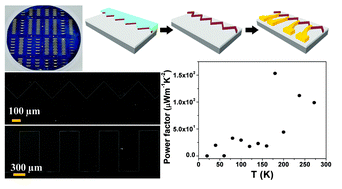Ultra-long bismuth telluridenanoribbons synthesis by lithographically patterned galvanic displacement†
Abstract
We demonstrated the wafer level batch synthesis and fabrication of single semiconducting thermoelectric

* Corresponding authors
a
Department of Chemical and Environmental Engineering, University of California-Riverside, Riverside, USA
E-mail:
myung@engr.ucr.edu
Fax: +1 951 827 5696
Tel: +1 951 827 7710
b Electrochemical Processing Group, Korea Institute of Materials Science, Changwon-Si, Kyungnam, South Korea
c Division of Materials and Chemical Engineering, Hanyang University, Ansan, South Korea
d Department of Physics and Astronomy, University of California-Riverside, Riverside, CA, USA
We demonstrated the wafer level batch synthesis and fabrication of single semiconducting thermoelectric

 Please wait while we load your content...
Something went wrong. Try again?
Please wait while we load your content...
Something went wrong. Try again?
H. Jung, Y. Rheem, N. Chartuprayoon, J. Lim, K. Lee, B. Yoo, K. Lee, Y. Choa, P. Wei, J. Shi and N. V. Myung, J. Mater. Chem., 2010, 20, 9982 DOI: 10.1039/C0JM02058C
To request permission to reproduce material from this article, please go to the Copyright Clearance Center request page.
If you are an author contributing to an RSC publication, you do not need to request permission provided correct acknowledgement is given.
If you are the author of this article, you do not need to request permission to reproduce figures and diagrams provided correct acknowledgement is given. If you want to reproduce the whole article in a third-party publication (excluding your thesis/dissertation for which permission is not required) please go to the Copyright Clearance Center request page.
Read more about how to correctly acknowledge RSC content.
 Fetching data from CrossRef.
Fetching data from CrossRef.
This may take some time to load.
Loading related content
